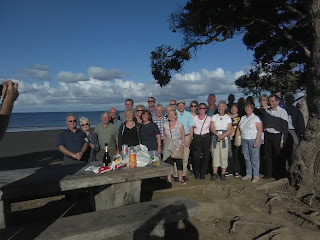Best of New Zealand - 27th February - Rotorua (2 nights)
Sunday 27th February – Rotorua
Rotorua (from Māori: Te Rotorua-nui-a-Kahumatamomoe, "The second great lake of Kahumatamomoe") is a city on the southern shores of the lake of the same name, in the Bay of Plenty region of the North Island of New Zealand. The city is the seat of the Rotorua District, a territorial authority encompassing the city and several other nearby towns. Rotorua city has an estimated permanent population of 55,900, with the Rotorua district having a total estimated population of 68,600.
Rotorua is a major destination for both domestic and international tourists; the tourism industry is by far the largest industry in the district. The city is known for its geothermal activity, and features geysers – notably the Pohutu Geyser at Whakarewarewa – and hot mud pools. This thermal activity is sourced to the Rotorua caldera, on which the city lies.
The name Rotorua comes from Māori, the full name being Te Rotorua-nui-a-Kahumatamomoe; roto means lake and rua two – Rotorua thus meaning 'Second lake'.Kahumatamomoe was the uncle of the Māori chief Ihenga, the ancestral explorer of the Te Arawa. It was the second major lake the chief discovered, and he dedicated it to his uncle. It is the largest of a multitude found to the north-east of the city, all connected with the Rotorua Caldera and nearby Mount Tarawera. The name can also mean the equally appropriate 'crater lake'.
The area was initially settled by Māori of the Te Arawa iwi. The first European in the area was probably Phillip Tapsell who was trading from the Bay of Plenty coast at Maketu from 1828. He later married into Te Arawa and became highly regarded by them. Missionaries Henry Williams and Thomas Chapman visited in 1831 and Chapman and his wife established a mission at Te Koutu in 1835. This was abandoned within a year but Chapman returned in 1838 and established a second mission at Mokoia Island.
The lake shore was a prominent site of skirmishes during the New Zealand Wars of the 1860s. A "special town district" was created in the 1883, in order to promote Rotorua's potential as a spa destination. The town was connected to Auckland with the opening of the Rotorua Branch railway and commencement of the Rotorua Express train in 1894, resulting in the rapid growth of the town and tourism from this time forward. Rotorua was established as a borough in 1922 and declared a city in 1962 before becoming a District in 1979.
Thermal activity is at the heart of much of Rotorua's tourist appeal. Geysers and bubbling mud-pools, hot thermal springs and the Buried Village (Te Wairoa) —so named after it was buried by the 1886 Mount Tarawera eruption.
Rotorua has a nickname Sulphur City, because of the hydrogen sulphide emissions, which gives the city a “rotten eggs” smell, as well as rotten-rua combining its legitimate name and the rotten smell the city gives.
The especially pungent smell in the central-east ‘Te Ngae’ area is due to the dense sulphur deposits located next to the southern boundary of the Government Gardens, in the area known as ‘Sulphur Point’.
Wai-O-Tapu (Māori for “Sacred Waters”) is an active geothermal area at the southern end of the Okataina Volcanic Centre, just north of the Reporoa caldera, in New Zealand's Taupo Volcanic Zone. The area has many hot springs noted for their colourful appearance, in addition to the Lady Knox Geyser. Prior to European occupation the area was the homeland of the Ngati Whaoa tribe who descended from those on the Arawa waka (canoe). The area also has a long history as a tourist attraction. While the area has been protected as a scenic reserve since 1931, a tourist operation occupies part of the reserve under a concession. It operates under the name "Wai-O-Tapu Thermal Wonderland".
Notable features include Lady Knox Geyser, Champagne Pool, Artist's Palette, Primrose Terrace and boiling mud pools.
The Lady Knox Geyser is a geyser in the Wai-o-Tapu area of the Taupo Volcanic Zone in New Zealand. It is named after Lady Constance Knox, the second daughter of Uchter Knox, 15th Governor of New Zealand. The visible spout is made of rocks placed around the base of the spring to enhance the eruption; over the years silica from the eruptions has built up to give a white cone-shaped appearance. Because the geyser was discovered early in the 20th century, it has no Māori name, unlike almost every other thermal feature in the region.
The geyser has two water chambers, one lower, hot one and one upper, cold one. The upper chamber cools due to a larger opening to the outside. The lower one heats up due to the volcanic activity below. When soap is thrown into the upper water chamber, the lowered surface tension of the water allows it to mix with the hotter water below, causing the eruption.
The Journey
A short journey to Wai-o-Tapu, first we shall visit the mud pools, then it is time to watch the Lady Knox Geyser, we then have a guided walking tour for approx 45 minutes to view the Champagne pools, later have lunch in the cafe before we depart for Rotorua, on arrival we head to Rainbow Springs for a guided walk looking out for, trout, tuatara, pigs, sheep, native birds and trees and New Zealand’s only ‘open to view’ kiwi hatchery and rearing facility. Later we travel to the Agrodome where we watch a Sheep Show with a difference. A short orientation of the city before arriving at out Hotel, The Heritage. This evening we have a Hangi, Maori show and dinner (buffet). Please meet in the lobby at 18.15.


Comments
Post a Comment